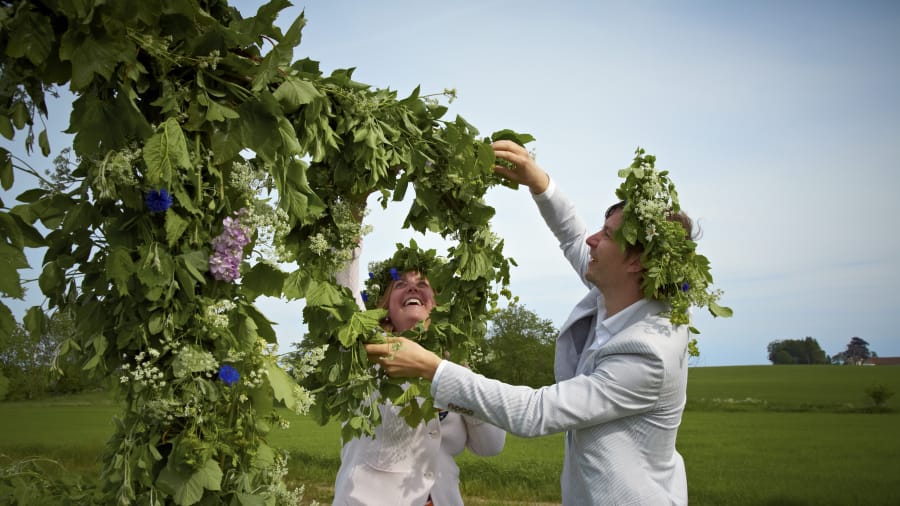The 11 best destinations in the world to spend the summer 0:54
(CNN) --
Do you feel a stirring in your heart?
Perhaps a jump in your libido?
Hell, are you just getting hot and restless?
The 2022 summer solstice is here. The longest day of the year in the Northern Hemisphere marks the official start of summer on the calendar, and with it comes maximum sunshine, lots of heat, romantic vibes, and the bounty of the harvest.
The solstice is historically associated with fertility, both of the plant and human variety, in destinations around the world.
CNN Travel explores some of those old-fashioned, sultry summer traditions.
But first, we'll take a look at some of the science.
Summer Solstice: Questions and Answers
Question: I like the precision.
When exactly is the summer solstice in 2022?
Answer: The answer depends on where you are during the solstice.
advertising
It will happen precisely at 09:13 UTC (Coordinated Universal Time) on Tuesday, June 21, according to NASA.
Your time zone relative to UTC determines the time and date the solstice occurs for you.
Here's how 9:13 UTC aligns with local time in select locations around the world (and look at the progression of time as we go from east to west):
• Guam: 7:13 p.m. Tuesday
• Tokyo, Japan: 6:13 pm Tuesday
• Manila, Philippines: 5:13 pm Tuesday
• Dhaka, Bangladesh: 3:13 pm Tuesday
• Dubai, United Arab Emirates: 1:13 pm Tuesday
• Istanbul, Turkey: 12:13 pm Tuesday
• Brussels, Belgium: 11:13 am Tuesday
• Casablanca, Morocco: 10:13 am Tuesday
• Recife, Brazil: 6:13 am Tuesday
• Boston, Massachusetts: 5:13 a.m. Tuesday
• Guadalajara, Mexico: 4:23 am Tuesday
• Calgary, Canada: 3:13 am Tuesday
• Seattle, Washington: 2:13 a.m. Tuesday
• Honolulu, Hawaii: 11:13 p.m. Monday
The TimeandDate website has a useful tool that allows you to calculate the time where you live.
Question: Is it the longest day of the year and does it happen all over the world?
Answer: No. It is the longest day in the Northern Hemisphere alone.
It is the shortest day of the year south of the equator.
Residents of the southern hemisphere, in places like Argentina, South Africa and New Zealand, are about to enter three months of winter.
And the differences in the amount of daylight become very dramatic as you get closer to the poles and further away from the equator.
In Quito, the capital of Ecuador, just north of the equator, people hardly notice the difference.
They get a measly seven extra minutes of daylight.
But residents north of Helsinki, Finland will see sunrise at 3:54 am and have nearly 19 hours of daylight.
Even the night doesn't get so dark.
Residents of Fairbanks in the central interior of Alaska can scoff at those 19 hours.
They'll get a whopping 21 hours and 41 minutes of daylight.
As for those poor penguins in Antarctica guarding their eggs, if they could talk, they could tell you a lot about living in 24-hour darkness.
Question: Why don't we just have 12 hours of daylight throughout the year?
Answer: People all over the planet actually received nearly equal doses day and night during the spring equinox.
But the amount of sunlight we get in the Northern Hemisphere has been increasing daily ever since.
Why?
That's because the Earth is aligned on an axis, an imaginary pole that runs through the center of our planet.
But this axis is tilted, at an angle of 23.5 degrees.
"As the Earth orbits the sun [once a year], its tilted axis always points in the same direction. So, during the year, different parts of the Earth receive the direct rays of the sun," according to NASA.
When the sun reaches its peak in the northern hemisphere, that is the summer solstice.
At that time, "the sun is directly over the Tropic of Cancer, which is located at 23.5° north latitude, passing through Mexico, the Bahamas, Egypt, Saudi Arabia, India and southern China," according to the Service. National Weather.
Sensual traditions: Summer solstice in Sweden
1 of 7
|
In many parts of the world, there is no better time for courtship than on the longest day of the year.
In Belarus, women and men take the opportunity to celebrate the midnight sun on Ivan Kupala Day by bathing in lakes.
2 of 7
|
During the Swedish national holiday of Midsommar, the normally cool, quiet and calm Swedes meet their raucous Viking roots, down copious amounts of vodka and dance, according to some, before a rather phallic-looking stake.
Perhaps unsurprisingly, research shows that many babies are born nine months after the holidays.
3 of 7
|
During the Greek solstice celebration, the Klidonas, bachelors all over the country try to impress single women by building bonfires and jumping over them.
According to custom, anyone who jumps the flames three times is rewarded with a good year ahead, but more importantly, a likely date night.
4 of 7
|
In Eastern Europe, solstice celebrations fall on Ivan Kupala Day, a holiday that has romantic overtones for many Slavs.
"Kupala" is derived from the same word as "Cupid".
In Ukraine, it is common for women to lay wreaths in a river to attract eligible bachelors.
5 of 7
|
In Belarus, women place candle offerings in rivers as they celebrate Ivan Kupala Day.
The pagan tradition has been accepted into the orthodox Christian calendar.
6 of 7
|
One of the world's largest solstice celebrations takes place at Stonehenge, a 5,000-year-old site where thousands gather each year for the start of the summer season.
7 of 7
|
The pagans and neodruids consider the solstice an option to celebrate marriages.
Many couples go to Stonehenge on Salisbury Plain to confirm their love on the longest day of the year in the Northern Hemisphere.
Now let's turn our attention to what we really have in mind: the romantic and sexy side of the solstice.
We will start in Sweden.
Their traditions include dancing around a maypole, a symbol some see as phallic.
They also feast on kippers and copious amounts of vodka (whether that's romantic or not is probably a matter of personal preference).
"Many children are born nine months after the summer solstice in Sweden," Jan-Öjvind Swahn, a Swedish ethnologist and author of several books on the subject, told CNN before his death in 2016.
"Drinking is the most typical summer solstice tradition. There are historic photographs of people drinking to the point where they can't go on anymore," Swahn said.
While libations influenced the later baby boom, Swahn noted that even without alcohol, the summer solstice is a time rich in romantic rituals.
"There used to be a tradition among single girls that if they ate something very salty during the summer solstice, or picked several different types of flowers and put them under their pillows when they slept, they dreamed of their future husbands," she said.
Pagan rites in Greece
There is a similar mythology about dreaming about the future spouse in some parts of Greece.
There, as in many European countries, the pagan solstice was co-opted by Christianity and renamed Saint John's Day.
Still, in many villages in the north of the country, ancient rites are still celebrated.
One of the oldest rituals is called Klidonas, and involves local virgins collecting water from the sea.
All the single women in the village place a personal belonging in the pot and leave it under a fig tree overnight.
So, according to folklore, the magic of the day imbues the objects with prophetic powers, and the girls in question dream of their future husbands.
The next day, all the women of the village get together and take turns taking out objects and reciting rhyming couplets that are intended to predict the romantic fate of the owner of the object.
These days, however, the festival is more of an excuse for the women's community to trade raunchy jokes.
"In my village, the older women always seem to come up with the dirtiest rhymes," says Eleni Fanariotou, who has filmed the custom.
Later in the day, the sexes mingle and take turns jumping over a bonfire.
Anyone who succeeds in jumping the flames three times must have one wish granted.
Fanariotou said that the festival often results in a coupling.
"It's a good time to meet someone, because all the young people in town go and it's a good opportunity to socialize. Also, all the men like to show off and make the biggest fire they can to jump."
a slavic cupid
In Eastern Europe, the summer solstice is associated with Ivan Kupala Day, a holiday with romantic connotations for many Slavs ("kupala" is derived from the same word as "cupid").
It's also called Kupala Night (apparently, love doesn't keep to a strict schedule).
"Once it was believed that Kupala night was a time for people to fall in love, and that those who celebrated it would be happy and prosperous throughout the year," recalls Agnieszka Bigaj of the Polish tourist office.
It used to be that young, single women floated wreaths in the river where eager bachelors on the other side tried to catch them, she adds.
According to Polish folklore, the man and woman in question would become a couple.
Bonfires are also a major feature of the holiday, and it is tradition for a couple to jump through the flames together while holding hands;
if they don't let go, it is said that their love will last.
Yoga in India and beyond
Few things put you in touch with your mind and body like yoga does.
In India, the birthplace of the ancient practice, the summer solstice is traditionally celebrated with mass yoga sessions across the country, the second most populous in the world.
And these days, yoga has spread all over the world.
In fact, International Yoga Day is June 21, the same day as the solstice.
The United Nations theme for 2022 is "Yoga for Humanity" and promotes the practice as a great method to overcome the effects of the pandemic.
In New York's Times Square, seize the daylight with solstice yoga classes starting at 7:30 am and ending at 8:30 pm Sign up early, or if you can't make it, join via streaming on the Times Square Alliance website, which features the event.
Traditions in China
Records from the Song dynasty (960 to 1279) indicate that officials could have three days off during the summer solstice, according to ChinaCulture.org.
It was called "chaojie" and "the women gave each other fans and colored bags. The fans could help them not to feel so hot and the bags were to drive away mosquitoes and make them smell good."
People in Mohe, China's northernmost city in Heilongjiang province, can enjoy nearly 17 hours of daylight, with sunrise coming at 3:23 am.
stonehenge
One of the most notable solstice celebrations in the world has traditionally taken place at Stonehenge, England, where thousands of people usually gather each year.
Like many other events in 2020 and 2021, they had to change traditions due to the pandemic.
But in 2022, the in-person celebration returns, according to English Heritage.
You can also watch the solstice sunrise live on the group's Facebook page or YouTube channel.
Stonehenge, dating back to Druid and pagan times, has a mysterious charm.
"All druidic rituals have an element of fertility, and the solstice is no exception," King Arthur Pendragon, a high-ranking archdruid, told CNN.
"We celebrate the union of the male and female deities, the Sun and the Earth, on the longest day of the year."
Part of this article came from a CNN story by Daisy Carrington first published in 2013.
SolsticeSummer














